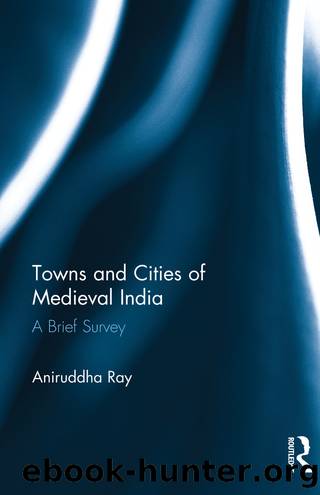Towns and Cities of Medieval India by Aniruddha Ray

Author:Aniruddha Ray [Ray, Aniruddha]
Language: eng
Format: epub
ISBN: 9789350981023
Google: uDXtsgEACAAJ
Publisher: Manohar
Published: 2015-01-15T06:03:30+00:00
Abdul Hamid Lahori had praised the resources and the financial abilities of Shahjahan. Akbar had left a huge wealth at the time of his death but much of this was spent during the time of Jahangir. Shahjahan managed to improve the financial status and after spending so much had left behind precious stones and jewellery to the amount of nearly Rs. 9 crore. One of the reasons was that he had fixed the revenue of khalisa land at Rs. 3 crore as a result of which one-seventh of the total income of the empire was kept reserved. It was not inconvenient for Shahjahan to spend nearly Rs. 3 crore on the construction of palaces, forts, gardens, etc. This is clearly reflected in the jamadami or estimated revenue. Half a century after Akbar this estimated revenue became double and continued to increase. Generally it has been suggested that this increase was due to the fact that four provinces of the Deccan and Baglana kingdom had come under the control of the Mughals. Shireen Moosvi has shown the increase in estimate after 1647 but this is not the place to discuss the details.
The inhabitants of Shahjahanabad used to live in different types of houses. The houses of the high nobles and the princes contained beautiful gardens, well-furnished rooms and canals full of water. The lower nobility and merchants used to live in houses constructed of brick and stone and roofed in tiles. From the contemporary Persian history it is learnt that the Hindu and Armenian merchants used to live in six-storeyed houses but their houses did not contain gardens or fountains. Ordinary traders used to live either above their shops or behind their shops. The ordinary traders, servants and artisans in most cases used to live inside the fort or just outside. With the increase in population the vacant lands were filled up. Even they descended on the road in such a way that in the early eighteenth century it was becoming difficult to walk through these roads. The existence of a large number of thatched houses created the possibility of fire. Three separate fires in 1662 killed nearly 60,000 people.
The high nobles and princes used to imitate the emperor in their manners and lifestyle. Their houses were constructed on the model of the palace. Some of these people had huge palaces on which foreign travellers and Indian writers have commented. A huge wall surrounded the house in front of which there was often a ditch. There was a Nakkar Khana next to which was the guard room. Beyond the gateway inside the house was a courtyard like the Jilu Khana where the servants used to wait for their masters with their horses. On both sides of the gate were the rooms for stables, godowns, workshops and rooms for servants along with some Soldiers. After crossing the first courtyard there were the residences of the princes and high nobles. This was also divided into two parts - one for personal use and the other was the office.
Download
This site does not store any files on its server. We only index and link to content provided by other sites. Please contact the content providers to delete copyright contents if any and email us, we'll remove relevant links or contents immediately.
| Central Asia | Southeast Asia |
| China | Hong Kong |
| India | Japan |
| Korea | Pakistan |
| Philippines | Russia |
The Sympathizer by Viet Thanh Nguyen(4093)
The Rape of Nanking by Iris Chang(4022)
World without end by Ken Follett(3341)
Ants Among Elephants by Sujatha Gidla(3279)
Blood and Sand by Alex Von Tunzelmann(3055)
Japanese Design by Patricia J. Graham(2998)
City of Djinns: a year in Delhi by William Dalrymple(2434)
Foreign Devils on the Silk Road: The Search for the Lost Treasures of Central Asia by Peter Hopkirk(2385)
Inglorious Empire by Shashi Tharoor(2345)
The Queen of Nothing by Holly Black(2313)
In Order to Live: A North Korean Girl's Journey to Freedom by Yeonmi Park(2302)
India's Ancient Past by R.S. Sharma(2293)
Tokyo by Rob Goss(2289)
India's biggest cover-up by Dhar Anuj(2242)
Tokyo Geek's Guide: Manga, Anime, Gaming, Cosplay, Toys, Idols & More - The Ultimate Guide to Japan's Otaku Culture by Simone Gianni(2239)
The Great Game: On Secret Service in High Asia by Peter Hopkirk(2228)
Goodbye Madame Butterfly(2162)
Batik by Rudolf Smend(2007)
Living Silence in Burma by Christina Fink(1977)
